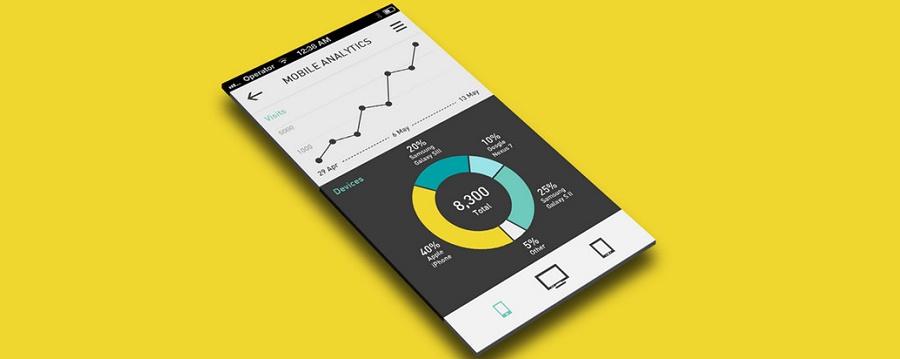Building the right content strategy for your mobile apps
When you are finished with the development of a mobile application for your business, it's a great opportunity to acquaint the application with the...


In the eternal quest for growth and superiority, you will come over multiple KPIs directed on making your app quicker, better, and powerful. Nowadays, each organization has its specific Key Performance Indicators and target objectives for their business.
Seizing data has never been less difficult, still, the more information we grab, the less we think about how to utilize it. It is particularly evident when it boils down to mobile application analytics.
The goal behind a KPI is to enable you to be unequivocal and limit analysis paralysis, which is important to dodge when promoting applications and can occur when you’ve various metrics disclosing distinctive things.
The vital inquiries, "What must I track and what mustn't I?" and "What will give me noteworthy information?" require answers, with 'significant information' being the driving terminal.
An application can have many KPIs that require tracking. Contingent upon what it is for, who it is for and how it works, application experts can concentrate on various aspects. In this blog post, we will cover the fundamental ones. Whatever your circumstance, here are 13 mobile metrics you totally should measure:
This one is by a wide margin one of the easiest approaches to understand the performance of your app. A download is a pivotal level in application selection because the various levels are based upon it. Thus, ensure you are tracking your application downloads appropriately.
Understanding why and when crashes are happening in your application is an answer to maintaining and improving your primary concerns. This KPI can be tracked in an assortment of ways like what are the cases paving the way to the crash? How often is your application crashing? Where in the application is a session crashing? What is the number of users been influenced by the application's crash?
Churn is a basic KPI. It implies tracking current users that choose to uninstall or unsubscribe the app. The lower the churn rate, more valuable it is. On the contrary, higher churn rate could be a sign of issues in the UI or UX or could be the users' reaction to occasional updates or patches.
Location metrics of a user are imperative application marketing KPIs because they disclose to you what is the location of your app users. Understanding the area of your users can enable you to comprehend why there are a larger number of users in a specific area than the other. Hence, recognizing such problems can enable you to advance your app to increase your audience.
The metrics of daily active users is used to signify the number of users who connect with your item minimum once every day. It is an indication of how much intrigue your application is getting on a particular day, as characterized by some kind of - action.
The retention rate of application is the users' percentage who visit your application minimum for once in a month. In the mobile application industry, retention rates are estimated through the span of one business quarter, i.e. 90 days’ time frame.
Locking users are one of the most noteworthy needs that a mobile application development group can have, as user maintenance is typically an immediate impression of your customer's satisfaction with your item.
Retention is but amongst the most troublesome metrics to develop, so it is best to center around developing your mobile application's retention from the very first moment.
Tracking uninstalls is as basic as following the number of installs or downloads. Bulk installations are regularly an indication that you have performed something incorrectly.
It may be the case, you have included a feature, but the users do not like it or an element that is meddling with user engagement. In the event that you notice to understand any uninstalls, endeavor to make sense of what the reason is and adjust it quickly.
How regularly do your customers visit your application?Session interval intends the time period between sessions.
By and large, shorter session interval is better. Prior to deciphering it, think on the tie between your application and specific time/occasion. In case that occasions are not essential for the visit, shorter session intervals might be a helpful KPI for you.
It is furthermore imperative how much time per session a customer has spent utilizing the application. It may give you plenty of acumens as of what to correct, alter or include so that the users remain longer on your app.
Organizations additionally ought to take a look at the organic growth of application installation— that is, the number of new downloads that do not appear straight from marketing efforts. In case that the level of new organic users develops after some time, it's a decent sign that the application has a solid viral coefficient, this suggests the current client base is sharing and raising new users for your app.
LTV is the measure of income you receive from a client amid their lifetime. This measurement is vital in deciding the value of every client portion. It additionally empowers you to settle on choices on the amount you should spend to get the distinctive clients. In assessing the lifetime value, you ought to consider the churn rate, the client's referral value and the abandonment rate of the application.
To guarantee you make gains from your mobile application, the LTV ought to constantly be higher than the customer acquisition cost. LTV likewise encourages you in anticipating the income your application will acquire in the coming future. You can broaden the lifetime evaluation of your customers by addressing their necessities.
The ideal strategy to do as such is by consistently reviewing the customer feedbacks. These can assist you in addressing their requirements. Timely acknowledgment to customer needs through responsive customer assistance likewise makes your application engaging to users.
Regardless of whether your application utilizes a membership model, in-app purchases, or ad revenue, pursuing your revenue is a reasonable indication of how effectively your mobile app is performing. You can address this by estimating the average income earned per client or the LTV earned per client.
In case that your application allows free users, you may likewise prohibit users who have never paid any income from your midpoints.
We live in a system where reviews and ratings describe one of the several major elements in making a buying decision.
The general success of your mobile app will be notably influenced by how users rate you and how you interact with your clients when doing corrections according to their feedback, reviews, or ratings
By analyzing distinctive metrics, and linking them together, you can get a pretty much total image of your application performance. Indeed, there are a lot of other KPIs which you can monitor as well. However, we chose these above-given factors for the impact and outcomes that they offer.These KPIs give a fair premise to picking what to control in your apps in order to manage both mobile app performance and user experience.
Need help with your app development? Get in touch.

When you are finished with the development of a mobile application for your business, it's a great opportunity to acquaint the application with the...

So you have developed an amazing application (need help? Check out this blog) and now are ready to release it. After developing an app, marketing is...